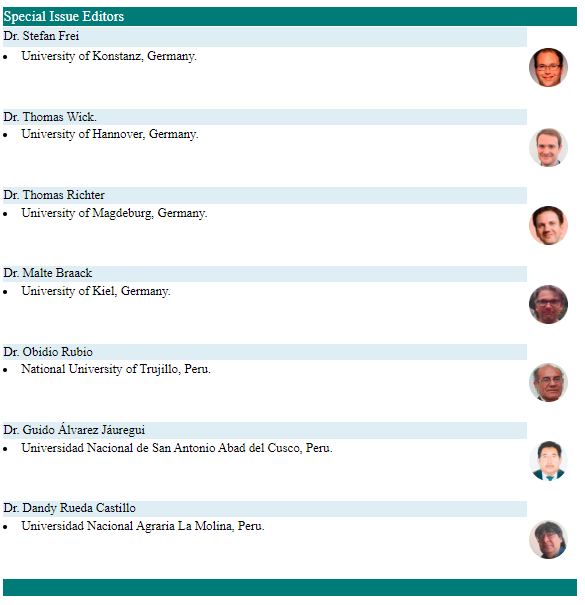The SIRD epidemiological model using Caputo fractional derivatives applied to study the spread of the COVID-19 in the Peruvian region of Tacna
DOI:
https://doi.org/10.17268/sel.mat.2024.02.03Keywords:
Fractional ordinary differential equations, Fractional derivatives and integrals, Caputo fractional derivative, SIRD model for infectious diseasesAbstract
Mathematical models are widely used to study the spreading dynamics of infectious diseases. In particular, the “Susceptibles-Infecteds-Recovereds-Deceases”(SIRD) model provides a framework that can be adapted to describe the core spreading dynamics of several human and wildlife infectious diseases. The present work uses a SIRD model using Caputo fractional derivative. In this investigation, the existence and uniqueness of solutions for the model were established. Numerical solutions were obtained using the Adams-Bashforth method. To illustrate the model’s utility, we made forecasts for the spread of the virus SARS-Cov-2 in the region of Tacna in Perú.
It is well known that these models can help to forecast the number of infected people, understand the disease dynamics and evaluate potential control strategies.
References
Benedictow OJ. The complete history of the Black Death. Woodbridge: Boydell & Brewer; 2021.
Kermack WO, McKendrick AG. A contribution to the mathematical theory of epidemics. Proceedings of the Royal Society of London Series A, Containing papers of a mathematical and physical character. 1927;115(772):700 -721.
Coayla-Teran EA. A COVID-19 time-dependent SIRD model using functional differential equations. International Journal of Ecology and Development. 2021;36(3):1-11.
Nisar KS, Ahmad S, Ullah A, Shah K, Alrabaiah H, Arfan M. Mathematical analysis of SIRD
model of COVID-19 with Caputo fractional derivative based on real data. Results in Physics.
;21:103772. Available from: https://www.sciencedirect.com/science/article/
pii/S2211379720321823.
Rezapour S, Mohammadi H, Samei ME. SEIR epidemic model for COVID-19 transmission by Caputo derivative of fractional order. Advances in difference equations. 2020;2020:1-19.
Alshomrani AS, Ullah MZ, Baleanu D. Caputo SIR model for COVID-19 under optimized fractional order. Advances in Difference Equations. 2021;2021(1):185.
Kilbas AA, Srivastava HM, Trujillo JJ. Theory and applications of fractional differential equations. vol. 204. Amsterdam: Elsevier; 2006.
Vargas-Pichón HB, Coayla-Teran EA, Tejada-Vásquez E. The SIRD epidemiological model applied to spread of the COVID-19 in the Peruvian region of Tacna. Selecciones Matemáticas. 2022;9(01):137 -144.
Vergara-Moreno E, et al. Modelo básico epidemiológico SIR para el COVID-19: caso las Regiones del Perú. Selecciones Matemáticas. 2020;7(01):151 -161.
DIRESA. Health directory of Tacna region in Peru;. May 2023. Available from: https://www.facebook.com/drstacna.
INEI. National Institute of Statistics and Computing of Peru;. June 2020. Available from:
https://www.inei.gob.pe/media/MenuRecursivo/publicacionesdigitales/Est/Lib1715/libro.pdf.
Brauer F, Castillo-Chavez C. Mathematical models in population biology and epidemiology. vol. 2. New York: Springer; 2012.
Downloads
Published
How to Cite
Issue
Section
License

This work is licensed under a Creative Commons Attribution 4.0 International License.
The authors who publish in this journal accept the following conditions:
1. The authors retain the copyright and assign to the journal the right of the first publication, with the work registered with the Creative Commons Attribution License,Atribución 4.0 Internacional (CC BY 4.0) which allows third parties to use what is published whenever they mention the authorship of the work And to the first publication in this magazine.
2. Authors may make other independent and additional contractual arrangements for non-exclusive distribution of the version of the article published in this journal (eg, include it in an institutional repository or publish it in a book) provided they clearly state that The paper was first published in this journal.
3. Authors are encouraged to publish their work on the Internet (for example, on institutional or personal pages) before and during the review and publication process, as it can lead to productive exchanges and to a greater and more rapid dissemination Of the published work.












